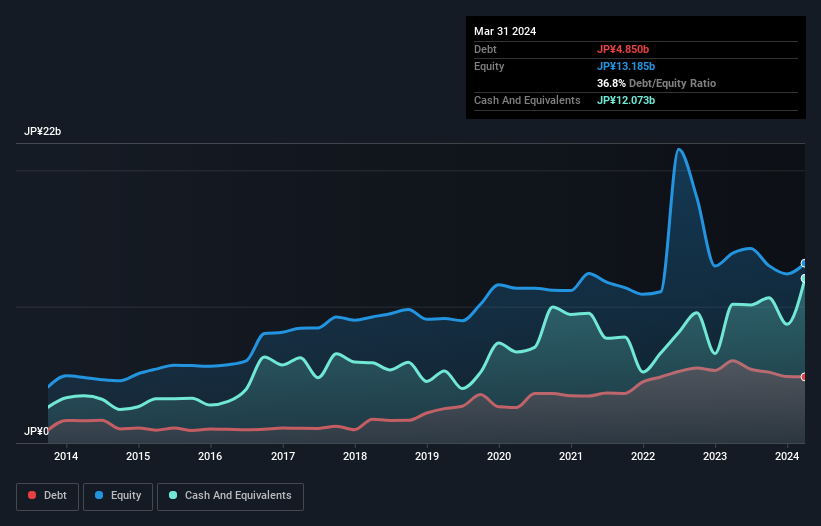Is BEENOS (TSE:3328) A Risky Investment?

David Iben put it well when he said, 'Volatility is not a risk we care about. What we care about is avoiding the permanent loss of capital.' When we think about how risky a company is, we always like to look at its use of debt, since debt overload can lead to ruin. As with many other companies BEENOS Inc. (TSE:3328) makes use of debt. But should shareholders be worried about its use of debt?
When Is Debt A Problem?
Debt assists a business until the business has trouble paying it off, either with new capital or with free cash flow. Ultimately, if the company can't fulfill its legal obligations to repay debt, shareholders could walk away with nothing. However, a more frequent (but still costly) occurrence is where a company must issue shares at bargain-basement prices, permanently diluting shareholders, just to shore up its balance sheet. Of course, debt can be an important tool in businesses, particularly capital heavy businesses. The first thing to do when considering how much debt a business uses is to look at its cash and debt together.
Check out our latest analysis for BEENOS
What Is BEENOS's Net Debt?
As you can see below, BEENOS had JP¥4.85b of debt at March 2024, down from JP¥6.03b a year prior. But it also has JP¥12.1b in cash to offset that, meaning it has JP¥7.22b net cash.

A Look At BEENOS' Liabilities
According to the last reported balance sheet, BEENOS had liabilities of JP¥15.7b due within 12 months, and liabilities of JP¥624.0m due beyond 12 months. On the other hand, it had cash of JP¥12.1b and JP¥7.07b worth of receivables due within a year. So it actually has JP¥2.83b more liquid assets than total liabilities.
This short term liquidity is a sign that BEENOS could probably pay off its debt with ease, as its balance sheet is far from stretched. Succinctly put, BEENOS boasts net cash, so it's fair to say it does not have a heavy debt load!
Better yet, BEENOS grew its EBIT by 122% last year, which is an impressive improvement. That boost will make it even easier to pay down debt going forward. There's no doubt that we learn most about debt from the balance sheet. But it is future earnings, more than anything, that will determine BEENOS's ability to maintain a healthy balance sheet going forward. So if you want to see what the professionals think, you might find this free report on analyst profit forecasts to be interesting.
But our final consideration is also important, because a company cannot pay debt with paper profits; it needs cold hard cash. BEENOS may have net cash on the balance sheet, but it is still interesting to look at how well the business converts its earnings before interest and tax (EBIT) to free cash flow, because that will influence both its need for, and its capacity to manage debt. During the last three years, BEENOS generated free cash flow amounting to a very robust 84% of its EBIT, more than we'd expect. That positions it well to pay down debt if desirable to do so.
Summing Up
While we empathize with investors who find debt concerning, you should keep in mind that BEENOS has net cash of JP¥7.22b, as well as more liquid assets than liabilities. And it impressed us with free cash flow of JP¥4.2b, being 84% of its EBIT. So we don't think BEENOS's use of debt is risky. There's no doubt that we learn most about debt from the balance sheet. However, not all investment risk resides within the balance sheet - far from it. Case in point: We've spotted 1 warning sign for BEENOS you should be aware of.
At the end of the day, it's often better to focus on companies that are free from net debt. You can access our special list of such companies (all with a track record of profit growth). It's free.
Valuation is complex, but we're here to simplify it.
Discover if BEENOS might be undervalued or overvalued with our detailed analysis, featuring fair value estimates, potential risks, dividends, insider trades, and its financial condition.
Access Free AnalysisHave feedback on this article? Concerned about the content? Get in touch with us directly. Alternatively, email editorial-team (at) simplywallst.com.
This article by Simply Wall St is general in nature. We provide commentary based on historical data and analyst forecasts only using an unbiased methodology and our articles are not intended to be financial advice. It does not constitute a recommendation to buy or sell any stock, and does not take account of your objectives, or your financial situation. We aim to bring you long-term focused analysis driven by fundamental data. Note that our analysis may not factor in the latest price-sensitive company announcements or qualitative material. Simply Wall St has no position in any stocks mentioned.
Have feedback on this article? Concerned about the content? Get in touch with us directly. Alternatively, email editorial-team@simplywallst.com
About TSE:3328
Excellent balance sheet with proven track record.
Market Insights
Community Narratives



